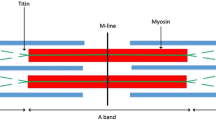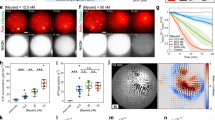Summary
1. The calcium requirement of the enzymatic activity of isolated muscle fibrils of Maia squinado is influenced only slightly by ionic strength between 0,05–0,21 μ. At every ionic strength the activity practically disappears when the concentration of free calcium ions ≦10−7 M and reaches a maximum for all ionic strength with a concentration of ∼10−5 M.
2. The mechanical activity shows a similar calcium requirement to the ATP splitting when the former is measured by the superprecipitation of isolated fibrils or by the development of tension of extracted fibres.
3. The degree of shortening of living fibres appears to depend in the same way on the concentration of free calcium ions as the tension development of extracted fibres.
4. The comparison between the calcium requirement found for isolated crab muscles and the reported one of isolated rabbit muscles reveals that the calcium requirement of both species is almost identical.
5. It is also possible to isolate from Maia muscles vesicles which 1. exhibit an “extrasplitting” (Hasselbach and Makinose 5) after the addition of calcium and 2. diminish the ATPase activity of fibril suspensions to one tenth when they are added to these. This inhibition of ATP splitting is reversed by calcium like the analogous inhibition by vesicles from rabbit muscle.
6. These observations demonstrate that the regulation of the muscular activity is identical in the living Maia fibre and in the glycerol-extracted fibre of the rabbit psoas.
Zusammenfassung
1. Der Calcium-Bedarf der enzymatischen Aktivität isolierter Muskelfibrillen von Maia Squinado wird von der Ionenstärke zwischen 0,05 und 0,21 μ nur unwesentlich beeinflußt. Die Aktivität ist praktisch bei allen Ionenstärken verschwunden, wenn die freie Calcium-Ionen-Konzentration ≦10−7 M ist, und sie ist für alle Ionenstärken maximal bei einer Calcium-Ionen-Konzentration ∼10−5 M.
2. Die mechanische Aktivität — gemessen als Superpräcipitation isolierter Fibrillen oder als Spannungsentwicklung extrahierter Fasern — zeigt einen ähnichen Calcium-Bedarf wie die ATP-Spaltung.
3. Der Verkürzungsgrad der lebenden Faser scheint in derselben Weise von der freien Calcium-Ionen-Konzentration abzuhängen wie die Spannungsentwicklung der extrahierten Faser.
4. Der Vergleich des Calcium-Bedarfs isolierter Crabbenmuskeln mit dem in der Literatur angegebenen Calcium-Bedarf isolierter Kaninchenmuskeln zeigt, daß der Calcium-Bedarf der beiden Tierarten fast gleich ist.
5. Auch aus Maia-Muskeln lassen sich Vesikel isolieren, die 1. auf Calcium-Zusatz eine „Extraspaltung“ nach Hasselbach u. Makinose 5 zeigen und die 2. bei Zusatz zu Fibrillensuspensionen deren ATPase-Aktivität auf ein Zehntel herabsetzen. Diese Hemmung der ATP-Spaltung wird durch Calcium-Zusatz ebenso aufgehoben wie die analoge Hemmung durch Vesikel aus Kaninchenmuskeln.
6. Diese Beobachtungen zeigen, daß die Regulierung der Muskelaktivität von der lebenden Maia-Faser bis zur glycerinextrahierten Faser des Kaninchen-Psoas gleichartig ist.
Similar content being viewed by others
Literatur
Caldwell, P. C.: Studies on the internal pH of large muscle and nerve fibres. J. Physiol. (Lond.) 142, 22–62 (1958).
Fiske, C. H., and Y. Subbarow: The colorimetric determination of phosphorus. J. biol. Chem. 66, 375–400 (1925).
Hasselbach, W.: Die Diffusionskonstante des Adenosintriphosphats im Inneren des Muskels. Z. Naturforsch. 7b, 334–337 (1952).
— ATP-Spaltung und aktiver Ionentransport. Arzneimittel-Forsch. (Drug Res.) 12, 877–881 (1962).
—, u. M. Makinose: Die Calcium-Pumpe der „Erschlaffungsgrana“ des Muskels und ihre Abhängigkeit von der ATP-Spaltung. Biochem. Z. 333, 518–528 (1961).
Hill, A. V.: The diffusion of oxygen and lactic acid through tissues. Proc. Roy. Soc. B 104, 39–96 (1929).
— The absence of lengthening during relaxation in a completely unloaded muscle. J. Physiol. (Lond.) 109, 8P-9P (1949).
Lundsgaard, E.: Über die Bedeutung der Argininphosphorsäure für den Tätigkeitsstoffwechsel der Crustaceenmuskeln. Biochem. Z. 230, 10–18 (1931).
Meyerhof, O., u. W. Schulz: Über das Verhältnis von Milchsäurebildung und Sauerstoffverbrauch bei der Muskelkontraktion. Pflügers Arch. ges. Physiol. 217, 547–573 (1927).
Nagai, T., M. Makinose u. W. Hasselbach: Der physiologische Erschlaffungsfaktorund die Muskelgrana. Biochim. biophys. Acta (Amst.) 43, 223–238 (1960).
Portzehl, H.: Muskelkontraktion und Modellkontraktion. Z. Naturforsch. 6b, 355–361 (1951).
— Bewirkt das System Phosphokreatin-Phosphokinase die Erschlaffung des lebenden Muskels? Biochim. biophys. Acta (Amst.) 24, 474–482 (1957).
— Die Bindung des Erschlaffungsfaktors von Marsh an die Muskelgrana. Biochim. biophys. Acta (Amst.) 26, 373–377 (1957).
— Der Calcium-Bedarf von Muskeln der Crabbe Maia Squinado für die Kontraktion. Pflügers Arch. ges. Physiol. 281, 71 (1964).
-- Unveröffentlichte Versuche.
—, and J. C. Rüegg: The dependence of contraction and relaxation of muscle fibres from the crab Maia squinado on the internal concentration of free calcium ions. Biochim. biophys. Acta (Amst.) 79, 581–591 (1964).
Rockstein, M., and P. W. Harron: Colorimetric determinations of inorganic phosphate in microgram quantities. Analyt. Chem. 23, 1500–1501 (1951).
Shaw, J.: Osmoregulation in the muscle fibres of carcinus maenas. J. exp. Biol. 35, 920–929 (1958).
Weber, A.: Muskelkontraktion und Modellkontraktion. Biochim. biophys. Acta (Amst.) 7, 214–224 (1951).
—, and R. Herz: Requirement of calcium in the synaeresis of myofibrils. Biochem. biophys. Res. Commun. 6, 364–368 (1962).
— The binding of calcium to actomyosin systems in relation to their biological activity. J. biol. Chem. 238, 599–605 (1963).
Author information
Authors and Affiliations
Additional information
Mit 5 Textabbildungen
Auszugsweise vorgetragen auf der 29. Tagung (Herbsttagung) der Deutschen Physiologischen Gesellschaft in Tübingen vom 29. September bis 3. Oktober 196414.
Rights and permissions
About this article
Cite this article
Portzehl, H., Zaoralek, P. & Grieder, A. Der Calcium-Spiegel in lebenden und isolierten Muskelfibrillen von Maia Squinado und seine Regulierung durch die sarkoplasmatischen Vesikel. Pflügers Archiv 286, 44–56 (1965). https://doi.org/10.1007/BF00362680
Received:
Issue Date:
DOI: https://doi.org/10.1007/BF00362680




